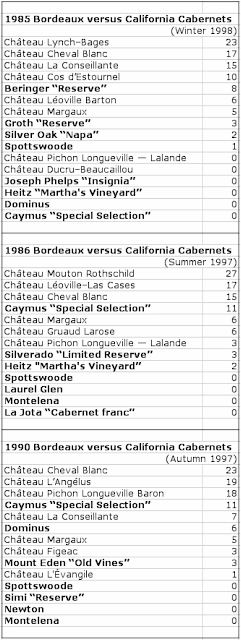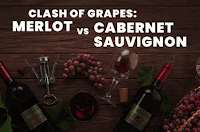In last week’s post, I used some data from a wine-tasting conducted by Bob Henry (What happens when you score wines at comparative tastings?). I looked at the odd effect in wine tastings, where the preferences for wines within a single flight of similar wines does not necessarily match the preferences produced when two flights are combined into a single group. Wine tasters are people, after all, and we reserve the right to do things our own way!
This week, I will take a retrospective look at three more of Bob’s tastings, from the end of the 1990s, in which his tasters compared red Bordeaux wines and California cabernets at the same session. Each tasting covered a different vintage, but only a few of the wineries were repeated across the vintages.
There were 15 participants at the Winter 1998 tasting of the 1985 vintage (wines 13 years old), with 8 Bordeaux wines and 8 California wines. There were 15 participants at the Summer 1997 tasting of the 1986 vintage (wines 11 years old), with 6 Bordeaux wines and 7 California wines. There were 16 participants at the Autumn 1997 tasting of the 1990 vintage (wines 7 years old), with 7 Bordeaux wines and 7 California wines.
The wines were tasted blind (ie. the bottle in a paper bag, although the order of wines was not random). Each person was asked to rank-order their three preferred wines from the total wines tasted for each vintage, which were then assigned points: 3 points for 1st preference, 2 points for 2nd preference, and 1 point for 3rd preference (yielding a total of 90, 90 and 96 points for the three tastings, respectively).
It is important to note that these results are relative only to each other, and there is thus no assessment of the wines on any absolute scale (eg. a score out of 100). Bob Henry made it clear in his comment on the previous post: “At my wine-tasting luncheons I never asked participants to assign a rating / score to any wine ... I knew each participant had her or his own interpretation of some undefined rating system ... I did believe that rank ordering (1st, 2nd, 3rd) would fairly elicit the degree of preference each participant found in the wines.” These results are from wine tasters, not wine critics.
The results of each of the tastings are summarized in these three tables. The wines are listed in decreasing score order within each tasting, with the California wines shown in bold-face.
There is usually one clearly preferred wine in each tasting (with a higher preference score than the others). The other wine preferences then drop off quickly, with quite a few wines at the bottom of each table that did not make it into anyone’s top-3 list.
In this regard, it is worth noting that Château Cheval Blanc (from the Saint-Émilion region of Bordeaux) makes it into into the Top-3 at all three tastings, while Château Margaux (Médoc First Growth) is in mid-table in all three cases. [1] Being a Bordeaux First Growth is not necessarily beneficial, apparently, although Château Mouton Rothschild (the other First Growth tasted) is at the top of the second table. Not all wines are always in form, apparently, especially when they are not at stage-managed events (Some wines are beyond criticism).
It is thus also interesting to note that what is clearly the top wine in the first tasting, Château Lynch–Bages, is actually a Médoc Fifth Growth of Bordeaux (the only one among the three tastings). The Médoc Second Growths tend to be down the lists a bit, while the Saint-Émilion wines tend to do quite well, in the top third of the lists. The Saint-Émilion wines are principally a Merlot blend, of course, rather than the Cabernet sauvignon of the Médoc. Château La Conseillante, a Merlot-based wine from Pomerol, also does well (in the first and third tastings).
Sadly, in all three tastings, the French wines were generally preferred to the U.S. Cabernet wines. The wines tasted cover many of the most famous names, mostly from the Napa Valley (Cabernet sauvignon is still Napa Valley’s top varietal; see: Napa County up 35% in crop value with record in wine grape production). Indeed, only the Caymus “Special Selection” (in the second and third tastings, but not the first tasting) and the Beringer “Reserve” (in the first tasting) got any sort of respectable placing. The Spottswoode did poorly in all three tastings, along with the Montelena in the second and third tastings, although the Dominus did better in the third tasting than it did in the first.
It is perhaps also of interest to compare these results to the current online review-site comments. Wine Searcher makes the current comments about the three vintages tasted:
1985 Vintage
Bordeaux: Excellent
California was the only major wine region outside of Europe to give a star performance.
1986 vintage
Bordeaux: Good
In the New World, both California and Australia enjoyed fantastic years.
1990 Vintage
Bordeaux: Legendary
In the New World, both California and Australia produced some fantastic wines.
These days, of course, the tendency is to note that the Bordeaux vintages are “Modern classic” wines (Bordeaux 2023: vintage overview), unlike the old-style vintages tasted here from the end of last century. Things have changed considerably for the Napa Valley in the ensuing quarter-century, as well, as they now give the Bordeaux wines a much clearer run for their money. However, there are recent comments that are clearly not in favour of California reds, compared to those from Europe (Dan Berger on wine: The reddish europhile).
Indeed, it is perhaps worth noting that most of the vineyards are composed of plants that are French vines grafted onto American rootstocks. This is due to the phylloxera outbreak in Europe, arising from transporting American vines to Europe (Did Darwin save wine?). Very few places in Europe avoided phylloxera (eg. Colares: wines by the waves). The US vines are also usually grafted, since the original French cultivars could not survive in the phylloxera-infested USA.
There are, of course, many many published comparisons of Napa wines with those of Bordeaux. One particularly relevant one here is that in Wine Spectator Sept. 15 1996, pp. 32—48.
[1] Bob Henry comments: “The 1990 Cheval Blanc is among the five best red wines I have ever tasted in my life. And has been every time I have tasted it. Simply sublime.”




No comments:
Post a Comment